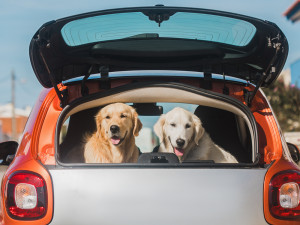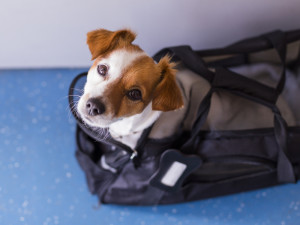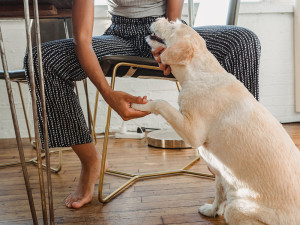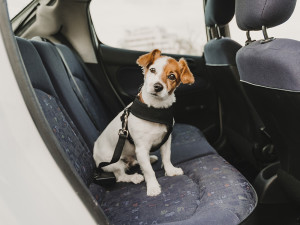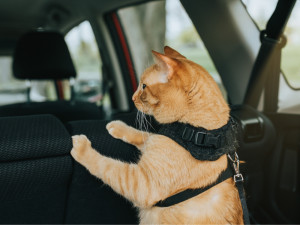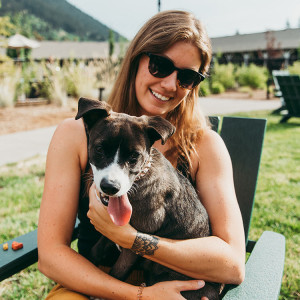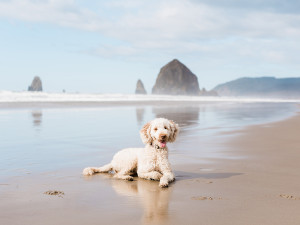How to Be a Digital Nomad — With a Pet
Keep these tips in mind, and you and your dog or cat can have all the adventures.

Share Article
At the end of 2020, Brienne Coates realized there was nothing keeping her in Chicago. Over the past few years, many of her friends and family had left the city, her relationship had ended, and because of the pandemic, her job became fully remote. So, she packed up her entire life, put it in a storage unit, leased an SUV, and in January 2021, set off to travel the country and discover new places. Two years later, she’s still at it, wandering from city to city, working remotely, and staying in Airbnbs and hotels. By her side the whole time: her loyal Sharpei, Buddha.
“Wherever I am, that’s where he wants to be,” Coates tells Kinship of Buddha. “He would rather be with me on the road than at home aloneopens in a new tab if I was going into the office.”
Coates wasn’t the only person who decided to hit the road during the pandemic. According to Forbesopens in a new tab, one study found that the number of U.S. workers who describe themselves as “digital nomads” — someone who works remotely and travels to different locations on a regular basis — is now roughly 15.5 million. This is a whopping 112 percent increase from 2019. Much of this growth has been attributed to the pandemic and the increase in flexible work models that allow employees to work from anywhere. As it turned out, when given the option, a lot of people wanted to work from the beach, from a ski chalet, or simply from a city with cheaper rent.
But as footloose and fancy-free as the digital nomad lifestyle may appear — floating from one scenic locale to another with only your laptop and your sense of adventure — things get more complicated when you have a pet. Traveling regularly with a pet requires lots of preparations, supplies, and care. If you’re willing to put in the work, though, the experience can be incredibly enriching — not just for you but your furry companion, too.
“It’s been great for Buddha to be exposed to so many different climates, and smells, and experiences,” Coates says. “You can tell that he’s very wise. You can tell that when he goes out in public he’s very calm. He knows how to act in situations. Everyone comments on how well-behaved he is.” Below, what you need to know about being a digital nomad with a pet in tow.
What sorts of jobs can a digital nomad have?
How does one earn money for themselves and their pups when they’re traveling all the time? If you’re like Coates, you might be lucky enough to work for a company that allows employees to work remotely. But if your company doesn’t allow remote work, or you’re looking for more flexibility, freelance work that can be done almost entirely online is a popular option among the professionally peripatetic.
Nathalie Mellaerts, who travels the worldopens in a new tab with her eight (!) dogs (she doesn’t always travel with all of them all at once), is a writer who focuses on blogging and short copy for social media. “If you’re looking for a creative job, being a copywriter or graphic designer is ideal as a digital nomad,” she says in an email, adding that e-commerce, web design, and coding are also good options.
What cities and countries are the most accommodating to pets?
When planning where you and your pet will travel next, do your homework first to see what cities are most pet-friendlyopens in a new tab. When in doubt, stick to bigger cities. Coates says she learned that major cities tend to be more welcoming to animals and often have more dog-friendly accommodations. “Dogs can’t go just anywhere, and they’re not necessarily welcomed in smaller cities in America yet,” she adds.
One of her favorite spots so far was Asheville, North Carolina. Coates was taken with how dog-friendly the city was; it has lots of dog parks and bars where your dog could join you inside. “On every corner there was something for your animals there.”
Mellaerts, who has traveled with her dogs all around Europe, says that in her experience, Italy is very dog-friendly, especially in the southern region, though dogs have to be muzzledopens in a new tab on public transportation. “I’ve never been denied entrance anywhere [in Italy,]” she says. “Except grocery stores.”
“My dogs got food faster than I did at most restaurants,” she says, jokingly, of Monaco and adds that Paris and London were also dog-friendly. Less pet-friendly, she found, were Portugal and Northern Spain, where she couldn’t bring her dogs with her into most restaurants or shops.
No matter where you’re going, but especially if you’re traveling overseas, make sure to do your research about what the rules are for dogs. Mellaerts notes that some countries don’t allow certain breeds of dogs and some require special vaccines. Check the requirements for each country before you travel there (the U.K., for example, requires dogs to have a heartwormopens in a new tab treatment done within a certain time frame before entering the country), make sure your pet’s vaccines are up-to-date, and if you’re traveling in Europe, you’ll need an EU pet passport.
Where can you stay?
Not all hotels or rental homes are pet-friendly, but if you do your research ahead of time, you can find spots that are accommodating. Coates and Buddha usually stay in dog-friendly Airbnbs, but as far as hotels go, she’s found that Marriotts are usually the safest bet when traveling with a pet.
Mellaerts said that when she first adopted her nomadic lifestyle, she drove a van that she would sleep in with her dogs, but she quickly decided that wasn’t for her. Now, she stays in Airbnbs where dogs are welcome. “Hosts leave you a review on Airbnb, so if you’re respectful and you clean up after yourself (and your dogs), you’ll get plenty of good feedback, and future hosts will be happy to have you,” she says.
What sort of gear will you need?
When you don’t have a single home base, you need to carry you everything you and your dog might need for any eventuality.
“Be prepared!” Mellaerts urges, adding that she always carries a dog first-aid kit, a muzzle, paw balm, cooling vests, jacketsopens in a new tab, and foldable food and water bowls. Both Coates and Mellaerts underscore how important it is to protect your dog’s feet. “If the floor is too hot for your bare feet, it’s too hot for your dog to walk on,” Mellaerts writes. Coates says she has booties opens in a new tabshe puts on Buddha to protect his feet from both overly hot and overly cold weather.
What your pet will need will depend on their needs and how you choose to travel. In addition to all sorts of bad-weather gear, Coates also has an elaborate car set up for Buddha to ensure that their long drives across the country go smoothly. Buddha has his own car bed, a seatbeltopens in a new tab, and fans in the back seat to keep him cool in the warmer months, just in case the car AC isn’t strong enough. Coates also sticks shades in the back windows — so that the sun doesn’t beat down on Buddha — and sets him up with a travel water bottle, his favorite bones, and a CBD gummy to keep him calm.
How can you help your dog adjust to travel?
The most important thing to remember when traveling with your pet is to keep an eye on how they’re feeling, and let them set the pace.
“Learn to recognize when your dog has had enough, and don’t push it,” Mellaerts says. She recommends setting aside days when you and your dog can rest and recharge and trying to stick to a routine as much as possible. “Give your dog time to adjust, and be patient,” she adds.
And make sure you know how to read your dog’s body language; this way, you can tell when they’re stressed or when they’ve had enough. Mellaerts recommends the book On Talking Terms with Dogs: Calming Signalsopens in a new tab (2005) by Turid Rugaas.
Coates also says that she has Buddha by her side during every step of a move, so that he can see what’s happening. He watches her pack up the bags and load up the car. “I’ll talk him through it, regardless of what he can or cannot understand,” she says. “He’s 100 percent a part of the journey.”

Madeleine Aggeler
Madeleine Aggeler is a freelance journalist and copywriter in Washington, D.C. Previously, she was a writer at New York magazine’s The Cut. She lives with her dog, Cleo, who works primarily as a foot warmer.
Related articles
![Portrait of a dog in a cowboy hat and handkerchief sitting atop a suitcase surrounded by other suitcases of army green and yellow set against a solid yellow background]() opens in a new tab
opens in a new tabThanks to July Luggage, Your Pet’s Face Will Greet You at Baggage Claim
Gives a whole new meaning to “where you lead, I will follow.”
![Andrew Knapp sitting with his two dogs.]() opens in a new tab
opens in a new tabAndrew Knapp Is Still Cruising
The Insta-famous photographer and #vanlife pioneer on how a game of hide and seek with his dog gleaned him digital fame and a book deal.
![Cat standing up in the back of a car]() opens in a new tab
opens in a new tabHow to Travel With a Cat (Without a Scratch)
Everything you need to bring your kitty home for the holidays, from an in-cabin carrier to calming products to a portable litter box.
![A woman petting her dog on a a chair at Outbound Hotel]() opens in a new tab
opens in a new tabWest Coast Dog-Friendly Travel Ideas
The best destinations for you and your co-pilot.
![A labradoodle dog sitting in the sand at Cannon Beach, Oregon.]() opens in a new tab
opens in a new tab5 Dog-Friendly Oregon Beaches
All 363 miles of the state’s coastline are publicly accessible, and almost beaches all are pet-friendly.
![Collage of Dave Coast and his dog with white outlines]() opens in a new tab
opens in a new tabDave Coast’s Favorite Sustainable Dog Products
The LA wellness guru (and his Poodle Stanley) vouches for recycled poop bags, bottle-opener collars, cruelty-free shampoo, celeb-approved dog beds, and more.
